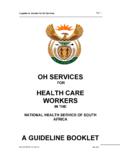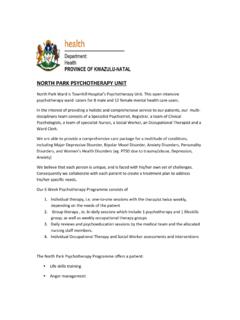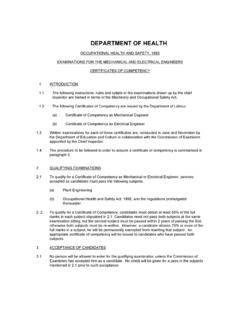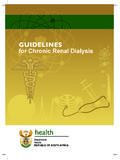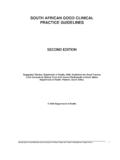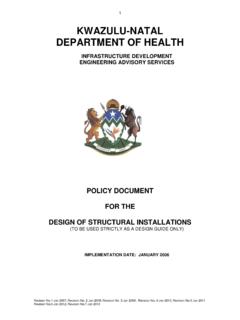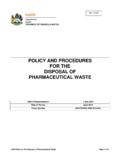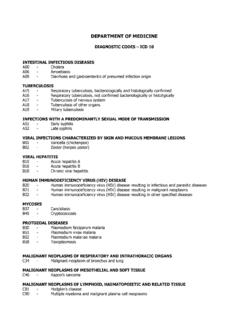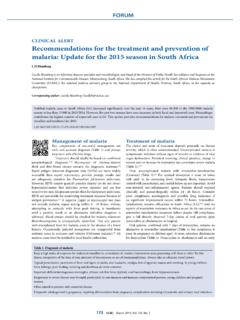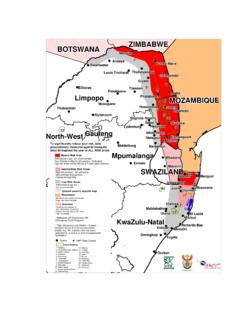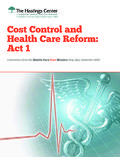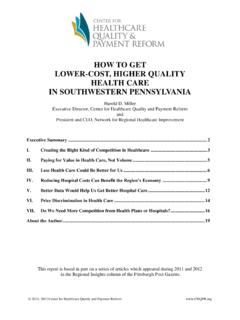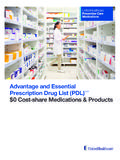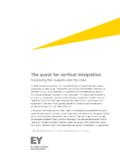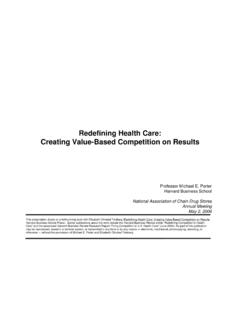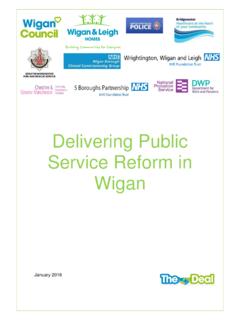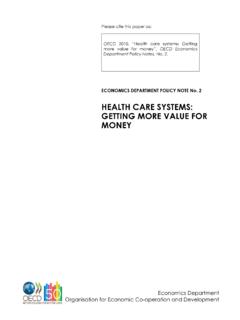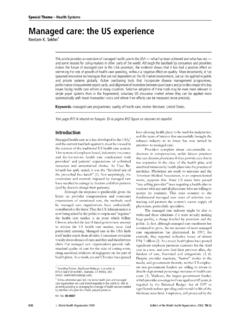Transcription of NATIONAL HEALTH INSURANCE: GREEN PAPER
1 NATIONAL HEALTH INSURANCENATIONAL HEALTH insurance : GREEN PAPERAUGUST 12 2011Dr Olive Shisana,Chair: Ministerial Advisory CommitteeChair: Ministerial Advisory CommitteeIntroductionIntroductionyTwo-ti ered financing HEALTH care system- with proportionately more resources serving a minorityyPublic sector is under-resourced and has to serve a l j it f th l tilarge majority of the populationyThe system is inequitable: all must benefit from NHIflllhdyTo successfully implement NHI there is a need to: Transform HEALTH system completelyhli Overhaul it Radically change administration and managementReengineer primary HEALTH care Re-engineer primary HEALTH careOutline: Problem statementOutline: Problem statementyBurden of DiseaseyQuality of HEALTH careyQuality of HEALTH careyHealth care expenditureiibi ffi ilyDistribution of financial and human resourcesdi l h i dyMedical scheme industryOutline: NATIONAL HEALTH insuranceOutline.
2 NATIONAL HEALTH insuranceHealth Policy ProposalsHealth Policy ProposalsFinancing proposalsFinancing proposalsHealth Policy ProposalsHealth Policy ProposalsFinancing proposalsFinancing proposalsyPrinciples yContracting of providersyPayment and reimbursement yObjectivesySocio-economic benefitsyUniversal and Population yPayment and reimbursement of providersyFunding mechanismsyCost yUniversal and Population coverageyPHC and HEALTH care cost yNHI FundyRole of Medical SchemesyPopulation Registration & BenefitsyAccreditation of providerspgInformation systemyMigration to NHIyPiloting of NHIprovidersBurden of DiseaseBurden of DiseaseyHIV/AIDS and TBDisproportionate burden ; yNon-communicable Disease Disproportionate burden ; of population and carry 17% of HIV + global populationDisease High blood pressure Diabetes, hhdpopulation High Tb rate globally and highest TB-HIV co-infection at 73% Chronic heart disease Chronic lung diseases Mental illnessinfection at 73%yMaternal.
3 Child and Infant MortalityV hihyInjury and Violence Road accidentsItl il d Very high AIDS and other causes contributes to this Interpersonal violence and violence against women and childrenQuality of HEALTH CareQuality of HEALTH CareyCleanlinessySafety and security of staff and patientsand patientsyLong waiting timesyStaff attitudesyInfection controlyDrug stock outsHealth care ExpenditureHealth care ExpenditureySouth Africa spends of GDP on healthp3 in the private HEALTH sector-coves of the population in the public HEALTH sector- covers 84% of the population4p4ppyPrivate hospital costs have increased by 120% over a decade (2008) too high a cost for usersgySource of funding for HEALTH care in SA: General revenueGeneral revenue Medical scheme contributions Out of pocket expensesOut of pocket expensesDistribution of Financial and human ResourcesDistribution of Financial and human ResourcesyMal-distribution of human resources between public pand private sector skews distribution in favour of the private sectoryPer capita spend vary: R11 150 per person in R11 150 per person in the private sector R2 766 per person in ppthe private sectorMedical Scheme IndustryMedical Scheme IndustryyReduction of medical schemes from >180 in 2001 to 102 ib hfiilliblin 2009 because they are not financially address the problem.
4 Increasing premiumsPremiums Increasing premiums Decreased member benefitsyResultWage inflationBrokers Benefits exhausted before year-end Wage inflation High cost of HEALTH careBrokersBenefits dd High cost of HEALTH careyCompounding problems High administrative feesreduced and exhausted Oversupply of brokersNational HEALTH InsuranceNational HEALTH InsurancePrinciples of NHIP rinciples of NHIyRight to access HEALTH care - Sect 27 of Constitutiong7ySocial Solidarity-cross-subsidisationyEffective ness-evidenced-based interventionsyEffectiveness-evidenced-ba sed interventionsyAppropriatenessihihdiiidyE quity-those with greatest need are prioritisedyAffordability-procure services at affordable costyEfficiency-eliminate duplicate administrative structures at NATIONAL , provincial and district spheresObjectives of NHIO bjectives of NHIyImproved access to quality HEALTH services Improved access to quality HEALTH services for all yCreate Single Fund: Pool risks and funds to yCreate Single Fund.
5 Pool risks and funds to achieve solidarityProcure ser ices on behalf of the entire yProcure services on behalf of the entire population if hbli hl hyImprove resourcing of the public HEALTH sectorSocioeconomic benefits of NHIS ocioeconomic benefits of NHIyA healthier population contributes to better wealth ppcreation{Each extra year of life expectancy raises country s GDP per person by 4% in the long runperson by ~4% in the long run{Poor HEALTH reductions in adult mortality explains 10-15% of the economic growth between 1960-1990 in 52 countries{Over 37 million Indians fall below poverty line because of catastrophic HEALTH spending Cover for allSouth Africans, permanent permanent residents and refugeesTourists, short-term residents, fi tdt foreign students must have travel insurance at Universal and Population Coverageentry into South AfricaPopulation CoveragePrimary HEALTH CarePrimary HEALTH CareySystem will be based on PHC and population-orientedyProvision of services will go beyond clinics, community HEALTH centers and hospitals to homes and communitiesyPrivate sector PHCyPHC focus will be on HEALTH promotion, preventive care .}}}
6 Curative and rehabilitative servicesyDefined package will be comprehensive at all levels and will yDefined package will be comprehensive at all levels and will guarantee continuity of careyPHC will be delivered Di t i tbd liil ilit t t{District-based clinical specialist support teams{School-based PHC services{Municipal Ward-based PHC agentsHealth care benefits under NHIH ealth care benefits under NHIyDistrict HEALTH Services{Designed to meet the needs of the populationyPrivate Providers{Accredited and contracted to provide a range of services{Accredited and contracted to provide a range of services{General practitioner to provide PHC services {Arrangement that reduces inconvenience to the patientyHospital Benefits{Evidenced-based comprehensive package of services for each level of care level of care {Hospitals redesignated as:District, Regional, Tertiary, Central and Specialised hospitalAccreditation of providersAccreditation of providersyEstablishment of Office of Standards and Compliance{Inspection{Norms and Standards{Norms and Standards{Office of ombudsmanySix core standards for HEALTH careyAccreditation standards{Specify minimum range of services to be provided{Delivery of PHC services linked to improved outcomes{Delivery of PHC services linked to improved outcomes{Skilled HEALTH and medical staff{Defined referral systemNHI: Financing proposalsNHI.}}}}}}}}}}}}}}}}}}}
7 Financing proposalsContracting ProvidersNHI FundDHAC ontract Accredited Public & monitorNHI FundDHAP ublic & Private ProvidersincentivisePayment and Reimbursement of providersPayment and Reimbursement of providersyAtPHC levels, reimbursement based on risk-,adjusted capitation linked to performanceyAt hospital levels, contracted and accredited facilities: global budgets and migrate to Diagnostic Related Groups linked to performancePbli iiitill bli h itl yPublic emergency services-initially public hospital global budget and then case-based mechanismyContracted provider emergency service: casebased yContracted provider emergency service: case-based approachCapitationCapitationyCapitation amount to be uniform across providersppyLinked to appropriate indexyRisk adjustments: population size, age, gender, jpp ,g,g,disease/epidemiological profileyCost-containment using treatment protocols and avoid under-servicingFunding mechanismsGeneral RevenueEmployersIndividualsPooled NHI FundPooled NHI FundRl R NHI (R bill)Rl R NHI (R bill)Real Recurrent NHI costs (R bill)Real Recurrent NHI costs (R bill)Ye a rNon-AIDS AIDSO ther AdminTo t a lYe a rNon-AIDS servicesAIDS servicesOther servicesAdminTo t a rendered not in accordance with the NHI treatment protocols and guidelines.
8 YHealth care benefits that are not covered under the NHI benefit packageyBy-pass referral system yServices that are rendered by providers that are not accredited and contracted by NHI Hlh i ilid b id yHealth services utilised by non-insured personsFlow of funds under NHIE ligible Population coco--payments if not payments if not Part of NHI protocolPart of NHI protocolAccredited ProvidersAccredited Providers/ HEALTH ServicesGen. tax revenue +EmployerID/NHI CardsReimbursementPerformance ManagementNHIF: Single PayerEmployer,MandatorycontributiongMemb ership to NHI is mandatoryVoluntary Medical Voluntary Medical Aid permittedNo tax subsidies for Medical Aid membersTop-up insurance Top-up insurance allowed and not opt outkill diRole of Medical SchemesSkilled persons in medical aid will be co-opted to work in a singlepayer NHI Schemesa single-payer NHI FundPopulation Registration and Information SystemPopulation Registration and Information SystemyOnly registered population will have access to ygppservices under and contracted HEALTH providers will only provide care to the registered card will be provided to allow for portability of electronic NATIONAL HEALTH Information system is essential for supporting service provision system is essential for supporting service provision under NHI and will provide basis for
9 Tracking population HEALTH . ppMigration to NHI1. NHI White PAPER and Legislative Process10 August 2011 December Release of GREEN PAPER for Public Consultation Launch of Final NHI Policy Document Commencement of NHI Legislative processDecember 2011 January reforms and Designation of HospitalsP bli ti f Rl ti D iti f Hit lAugust 2011At 2011 Publication of Regulations on Designation of Hospitals Policy on the management of hospitals Advertisement and appointment of HEALTH facility managers August 2011 October 20113 Hospital Reimbursement reformApril Reimbursement reform Regulations published for comment on Hospital Revenue Retention Development of a Coding SchemeApril 2011 January 2012 Development of a Coding SchemeMigration, Cont4. Establishment Office of HEALTH Standards Compliance (OHSC)August 2011 Compliance (OHSC) Parliamentary process on the OHSC Bill Appointment of staff (10 inspectors appointed)gJanuary 20125P bli Hlth Filit A dit Qlit HEALTH Facility Audit, Quality Improvement and Certification Audit of all public HEALTH facilities 21 % already audited (876 facilities)End July 2011by end of December 2011 21 % already audited (876 facilities) 64% completed (2927 facilities) 94% completed (3962 facilities)
10 Selection of teams to support the development and support by end March 2012 October 2011 Selection of teams to support the development and support of quality improvement plans and HEALTH systems performance Initiate inspections by OHSC in audited and improved February 2012 March 2012 Initiate inspections by OHSC in audited and improved facilities Initiation of certification of public HEALTH facilitiesMigration, cont d6. Appointment of District Clinical Specialists* Support Idtifi ti f t d dt August 2011Db Identification of posts and adverts Appointment of specialists Contract with academic institutions on a rotational schemeDecember 2011 February 20127. Municipal Ward-based Primary HEALTH care (PHC) Agents Training of first 5000 PHC AgentsDecember 2011 March 2012 Training of first 5000 PHC Agents Appointment of first 5000 PHC Agents Appointment of PHC teams March 2012 April 20128.
